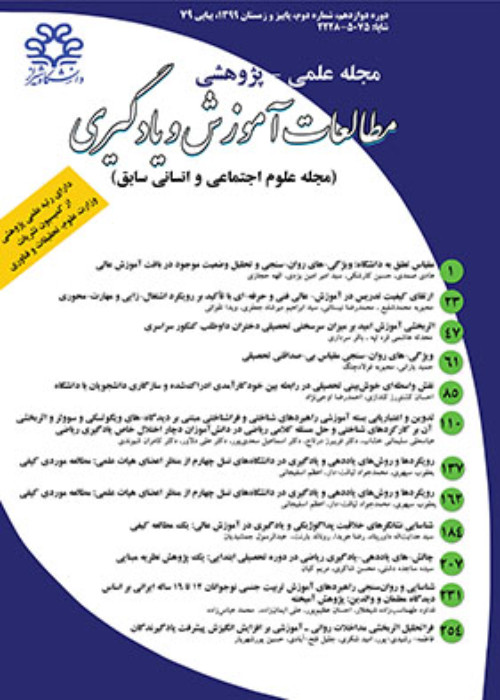The Relationship between Thinking Styles and Learning Approaches with Academic Achievement among Male and Female University Students
Author(s):
Abstract:
BackgroundTraditionally, many psychologists and educators have believed that student's success and failures are attributable mainly to individual differences in ability. However, individual differences in abilities cannot answer such questions as "why do some students get straight, as whereas others with equal abilities flunk out?" As a response to the recognition that individual differences in abilities provide only part of the answer to why students differ in their academic performance, many scholars began investigating the predictive value of non-ability measures for academic achievement among male and female university students (Sternberg & Williams, 1997). Two examples of these measures are thinking styles (Sternberg, 2009, Zhang, 2004) and learning approaches (Diseth, 2003; Duff, Boyle, Dunleavy & Ferguson, 2004).In Sternberg's theory of mental self-government, thinking styles are our preferred ways of using the abilities that we have. The theory delineates 13 thinking styles that fall along five dimensions, these are: 1) functions (legislative, executive, judicial), 2) forms (monarchic, hierarchic, oligarchic, anarchic), 3) levels (global, local), 4) scopes (internal, external), and 5) leanings (liberal, conservative).In Biggs's theory of approaches to learning or 3P model, there are three common approaches to learning: surface, which involves a reproduction of what is taught to meet the minimum requirements, deep, which involves a real understanding of what is learned, and achieving, which involves using a strategy that will maximize one's grades. Each approach is composed of two elements: motive and strategy. Motive describes why students choose to learn, whereas strategy describes how students go about their learning (Zhang & Sternberg, 2000; Zhang, 2002). ObjectiveThe main goal of this study was to examine the relationship between the thinking styles and learning approaches with academic achievement of male and female students. MethodA total of 386 students [56 male (M=22/1, SD=2/1) and 230 female (M=21/1, SD=1/8)] completed the Short Version of General Thinking Styles Inventory and Study Process Questionnaire were applied. Student's average scores were obtained from the university administrations and were used as a measure of academic achievement. Multivarate analysis of variance (MANOVA) was used to examine gender differences on the thinking styles and learning approaches. Multiple regression analyses were conducted to examine the relationship between the thinking styles and learning approaches with academic achievement. ResultsResults from calculating the correlations between thinking styles and learning approaches with academic achievement indicated that correlation coefficients among legislative, judicial, liberal, hierarchic, global, external, monarchic, oligarchic thinking styles and deep learning approach with academic achievement were positive and significant and, correlation coefficients among executive, local, conservative, internal thinking styles and surface learning approach with academic achievement were negative and significant. The correlation between anarchic thinking style and academic achievement was not statistically significant.Results of stepwise regression analyses using the thinking styles and learning approaches as the predictor indicated those legislative, judicial, liberal, hierarchic, global, external, oligarchic, executive, local, conservative, internal thinking styles and deep and surface learning approaches statistically contributed to student's academic achievement. The signs of beta weights showed that legislative, judicial, liberal, hierarchic, global, external, monarchic, oligarchic thinking styles and deep learning approach negatively contributed to academic achievement scores and executive, local, conservative, internal thinking styles and surface learning approach positively contributed to academic achievement scores.The results of MANOVA showed a significant difference between males and females in global, internal, hierarchical, monarchic and anarchic thinking styles and non-significant difference between male and female in learning approaches. DiscussionConsistent with previous finding that studied the contribution of thinking styles and approaches to learning (e.g., Grigorenko & Strernberg, 1997; Sternberg & Grigorenko, 1993); results of the present study identified the contributions of thinking styles and approaches to learning to student's academic achievement. The relationships between thinking styles and learning approaches to academic achievement scores could be explained by personality traits. It could be that participants who are used to employing the legislative, judicial, liberal, hierarchic, global, external, oligarchic, executive, local, conservative, internal thinking styles and deep learning approach had higher scores in extraversion, conscientiousness and openness to experience personality factors and participants who are used to employing the executive, local, conservative, internal thinking styles and surface learning approach had higher score in neuroticism personality factor. ConclusionIn general, the results of this research demonstrate that attention to the role of thinking styles and learning approaches on academic achievement of university students is crucial. On the other hand, this investigation reports that student's academic achievement is predicted by their thinking styles and learning approaches. We encourage the development of further research examining the relationship between thinking styles and learning approaches with academic achievement among students of different fields. It might also be interesting to examine the predictive validity of these relations by examining performance in different types of assessments, rather than the use of a global grade point average, to gain more specific knowledge about the relationship between thinking styles and approaches to learning with academic achievement scores in male and female university students.
Language:
Persian
Published:
Studies in Learning & Instruction, Volume:2 Issue: 1, 2011
Page:
69
magiran.com/p966253
دانلود و مطالعه متن این مقاله با یکی از روشهای زیر امکان پذیر است:
اشتراک شخصی
با عضویت و پرداخت آنلاین حق اشتراک یکساله به مبلغ 1,390,000ريال میتوانید 70 عنوان مطلب دانلود کنید!
اشتراک سازمانی
به کتابخانه دانشگاه یا محل کار خود پیشنهاد کنید تا اشتراک سازمانی این پایگاه را برای دسترسی نامحدود همه کاربران به متن مطالب تهیه نمایند!
توجه!
- حق عضویت دریافتی صرف حمایت از نشریات عضو و نگهداری، تکمیل و توسعه مگیران میشود.
- پرداخت حق اشتراک و دانلود مقالات اجازه بازنشر آن در سایر رسانههای چاپی و دیجیتال را به کاربر نمیدهد.
In order to view content subscription is required
Personal subscription
Subscribe magiran.com for 70 € euros via PayPal and download 70 articles during a year.
Organization subscription
Please contact us to subscribe your university or library for unlimited access!


